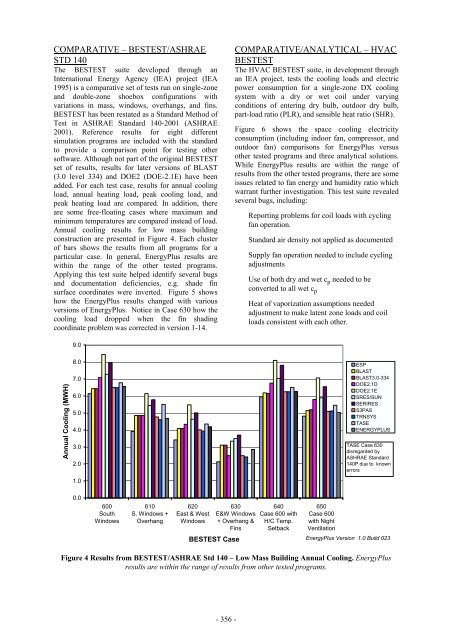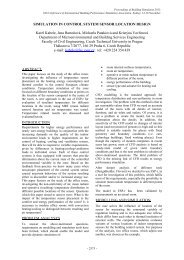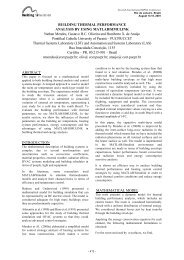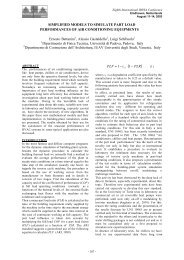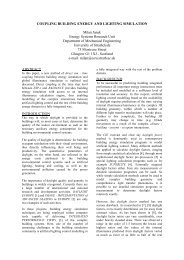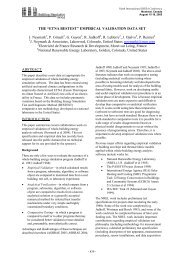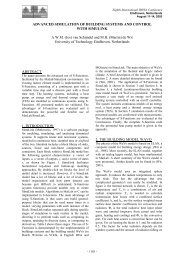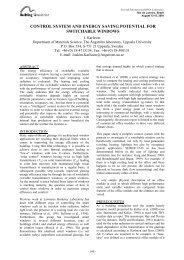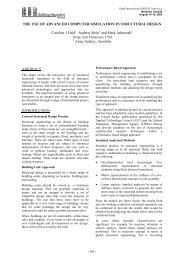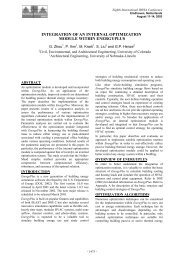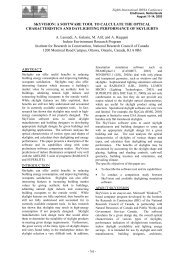testing and validation of a new building energy simulation ... - ibpsa
testing and validation of a new building energy simulation ... - ibpsa
testing and validation of a new building energy simulation ... - ibpsa
You also want an ePaper? Increase the reach of your titles
YUMPU automatically turns print PDFs into web optimized ePapers that Google loves.
COMPARATIVE – BESTEST/ASHRAE<br />
STD 140<br />
The BESTEST suite developed through an<br />
International Energy Agency (IEA) project (IEA<br />
1995) is a comparative set <strong>of</strong> tests run on single-zone<br />
<strong>and</strong> double-zone shoebox configurations with<br />
variations in mass, windows, overhangs, <strong>and</strong> fins.<br />
BESTEST has been restated as a St<strong>and</strong>ard Method <strong>of</strong><br />
Test in ASHRAE St<strong>and</strong>ard 140-2001 (ASHRAE<br />
2001). Reference results for eight different<br />
<strong>simulation</strong> programs are included with the st<strong>and</strong>ard<br />
to provide a comparison point for <strong>testing</strong> other<br />
s<strong>of</strong>tware. Although not part <strong>of</strong> the original BESTEST<br />
set <strong>of</strong> results, results for later versions <strong>of</strong> BLAST<br />
(3.0 level 334) <strong>and</strong> DOE2 (DOE-2.1E) have been<br />
added. For each test case, results for annual cooling<br />
load, annual heating load, peak cooling load, <strong>and</strong><br />
peak heating load are compared. In addition, there<br />
are some free-floating cases where maximum <strong>and</strong><br />
minimum temperatures are compared instead <strong>of</strong> load.<br />
Annual cooling results for low mass <strong>building</strong><br />
construction are presented in Figure 4. Each cluster<br />
<strong>of</strong> bars shows the results from all programs for a<br />
particular case. In general, EnergyPlus results are<br />
within the range <strong>of</strong> the other tested programs.<br />
Applying this test suite helped identify several bugs<br />
<strong>and</strong> documentation deficiencies, e.g. shade fin<br />
surface coordinates were inverted. Figure 5 shows<br />
how the EnergyPlus results changed with various<br />
versions <strong>of</strong> EnergyPlus. Notice in Case 630 how the<br />
cooling load dropped when the fin shading<br />
coordinate problem was corrected in version 1-14.<br />
COMPARATIVE/ANALYTICAL – HVAC<br />
BESTEST<br />
The HVAC BESTEST suite, in development through<br />
an IEA project, tests the cooling loads <strong>and</strong> electric<br />
power consumption for a single-zone DX cooling<br />
system with a dry or wet coil under varying<br />
conditions <strong>of</strong> entering dry bulb, outdoor dry bulb,<br />
part-load ratio (PLR), <strong>and</strong> sensible heat ratio (SHR).<br />
Figure 6 shows the space cooling electricity<br />
consumption (including indoor fan, compressor, <strong>and</strong><br />
outdoor fan) comparisons for EnergyPlus versus<br />
other tested programs <strong>and</strong> three analytical solutions.<br />
While EnergyPlus results are within the range <strong>of</strong><br />
results from the other tested programs, there are some<br />
issues related to fan <strong>energy</strong> <strong>and</strong> humidity ratio which<br />
warrant further investigation. This test suite revealed<br />
several bugs, including:<br />
<br />
<br />
<br />
<br />
<br />
Reporting problems for coil loads with cycling<br />
fan operation.<br />
St<strong>and</strong>ard air density not applied as documented<br />
Supply fan operation needed to include cycling<br />
adjustments<br />
Use <strong>of</strong> both dry <strong>and</strong> wet c p needed to be<br />
converted to all wet c p<br />
Heat <strong>of</strong> vaporization assumptions needed<br />
adjustment to make latent zone loads <strong>and</strong> coil<br />
loads consistent with each other.<br />
9.0<br />
Annual Cooling (MWH)<br />
8.0<br />
7.0<br />
6.0<br />
5.0<br />
4.0<br />
3.0<br />
2.0<br />
ESP<br />
BLAST<br />
BLAST3.0-334<br />
DOE2.1D<br />
DOE2.1E<br />
SRES/SUN<br />
SERIRES<br />
S3PAS<br />
TRNSYS<br />
TASE<br />
ENERGYPLUS<br />
TASE Case 630<br />
disregarded by<br />
ASHRAE St<strong>and</strong>ard<br />
140P due to known<br />
errors<br />
1.0<br />
0.0<br />
600<br />
South<br />
Windows<br />
610<br />
S. Windows +<br />
Overhang<br />
620<br />
East & West<br />
Windows<br />
630<br />
E&W Windows<br />
+ Overhang &<br />
Fins<br />
640<br />
Case 600 with<br />
H/C Temp.<br />
Setback<br />
650<br />
Case 600<br />
with Night<br />
Ventilation<br />
EnergyPlus Version 1.0 Build 023<br />
BESTEST Case<br />
Figure 4 Results from BESTEST/ASHRAE Std 140 – Low Mass Building Annual Cooling. EnergyPlus<br />
results are within the range <strong>of</strong> results from other tested programs.<br />
- 356 -


